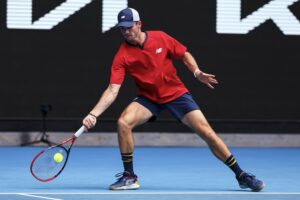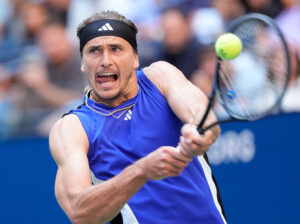In Tour-level matches before this year’s Wimbledon, Denis Kudla owned a win/loss record of 35% (53-99). That is combined of a rather dreadful 29% on hard courts (26-64) and 26% on clay (5-14). While Kudla has enjoyed a lot of success on other surfaces on the Challenger circuit (five titles and eight runner-up finishes on hard; one title on green clay), it is only on the grass where he’s been able to consistently win matches in ATP events, racking up 22 wins and 21 losses.
In tennisabstract’s grass ELO rankings, which take into account the ratings of the players you beat or lose to, Kudla is situated in the 26th spot after his successful qualifying campaign. While perhaps a bit skewed because he plays more on grass than many higher-ranked players, it is a much better reflection of where he stands on the surface right now than his 114th spot in the ATP Rankings.
Wimbledon is the only Grand Slam where he’s been past the third round (2015, lost to Marin Cilic in four sets). On top of that, Kudla made just six ATP quarterfinals in his career, four of them on the lawn (Stuttgart, Halle, Queen’s Club, Newport). He also scored one of his two top 20 victories on grass (against Gael Monfils at Stuttgart).
Speeding up on grass
Fast forward to 2021. Kudla is still doing the most damage on his favorite surface. While he had a couple of great results on American soil earlier in the year (Orlando Challenger runner-up, Tallahassee Challenger semifinalist), it was right after the French Open when the 28-year-old turned it up a notch. Kudla made the finals at Nottingham Challenger, where he also scored a fantastic win over then-World No. 27 Dan Evans in the quarterfinals. In the second edition of that event, he scored another impressive win, over former Wimbledon runner-up Kevin Anderson.
Starting Wimbledon from the qualifying stage
In that form, he was instantly regarded as one of the threats at Wimbledon qualifying in Roehampton. Seeded sixth, the American was drawn into a difficult section with former greats like Lukas Rosol and Ivo Karlovic. Both of these went out in the first round, though. While Kudla’s draw opened up, his campaign was impressively dominant. In seven sets required to qualify, he was only broken once–by Kacper Zuk–and only allowed his opponents to get to a single tie-breaker.
The opening round of Wimbledon saw Kudla face its 2017 boys’ singles champion, Alejandro Davidovich Fokina. The young Spaniard is yet to achieve much on this surface in professional tennis, which led to a very competitive match. Kudla went down two sets to love and looked out. But for the third time in his career, he managed to produce a beautiful come-back win. He was by far the better player towards the end, dropping four points in his last six service games.
On Wednesday (or whenever the weather will allow it), Kudla takes on another veteran, Andreas Seppi, in the second round. Should he come through, he could be slated for another meeting with Novak Djokovic, who eliminated him in straight sets at both Wimbledon and the US Open in the past. However, at both Majors, Kudla managed to impress the crowd by standing up to the Serb in the baseline rallies. While he never really had a shot at winning, he came out with intent and played his best game to try to challenge the World No. 1.
Why is Kudla a threat on grass?
So what makes Kudla such a deadly grass-court player? The American is famous for his flat double-handed backhand, a very natural fit for this surface. The balls coming off that stroke are even more low-skidding than usual, Kudla’s opponents into uncomfortable positions. The compact nature of his strokes allow him to easily handle the extra pace of the surface and keep the ball in the court with his very clean ball-striking. The American isn’t the most powerful player on the circuit but he’s extremely solid. On grass, those groundstrokes turn into really potent weapons. He’s been extremely efficient in deciding sets too, winning seven out of eight on grass this year.
It’s a pretty safe assumption that with a truly elite serve, Kudla could have accomplished much more this surface, as the bounce and the speed of play is such a perfect fit for his strokes. It’s worth remembering that the American achieved all that with just about a month of play on grass each season. In the current calendar, the most traditional surface to play tennis on is merely a novelty. Fewer and fewer players decide to focus on perfecting their grass games. Kudla is one of the select few whose performances on the lawn are so much better than on the surfaces with more presence on the circuit.
Main Photo:
Embed from Getty Images






